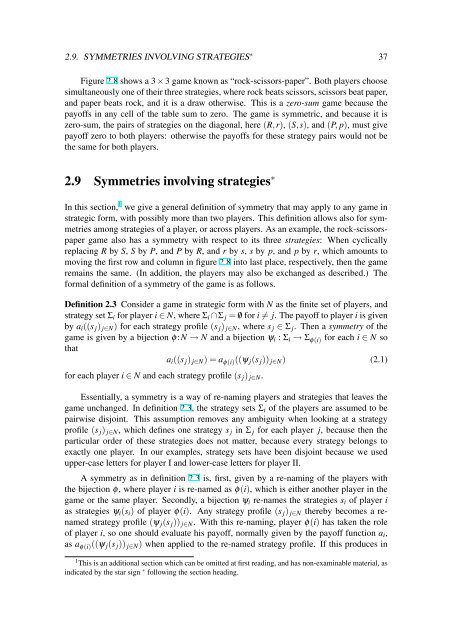Game Theory Basics - Department of Mathematics
Game Theory Basics - Department of Mathematics
Game Theory Basics - Department of Mathematics
You also want an ePaper? Increase the reach of your titles
YUMPU automatically turns print PDFs into web optimized ePapers that Google loves.
2.9. SYMMETRIES INVOLVING STRATEGIES ∗ 37Figure 2.8 shows a 3 × 3 game known as “rock-scissors-paper”. Both players choosesimultaneously one <strong>of</strong> their three strategies, where rock beats scissors, scissors beat paper,and paper beats rock, and it is a draw otherwise. This is a zero-sum game because thepay<strong>of</strong>fs in any cell <strong>of</strong> the table sum to zero. The game is symmetric, and because it iszero-sum, the pairs <strong>of</strong> strategies on the diagonal, here (R,r), (S,s), and (P, p), must givepay<strong>of</strong>f zero to both players: otherwise the pay<strong>of</strong>fs for these strategy pairs would not bethe same for both players.2.9 Symmetries involving strategies ∗In this section, 1 we give a general definition <strong>of</strong> symmetry that may apply to any game instrategic form, with possibly more than two players. This definition allows also for symmetriesamong strategies <strong>of</strong> a player, or across players. As an example, the rock-scissorspapergame also has a symmetry with respect to its three strategies: When cyclicallyreplacing R by S, S by P, and P by R, and r by s, s by p, and p by r, which amounts tomoving the first row and column in figure 2.8 into last place, respectively, then the gameremains the same. (In addition, the players may also be exchanged as described.) Theformal definition <strong>of</strong> a symmetry <strong>of</strong> the game is as follows.Definition 2.3 Consider a game in strategic form with N as the finite set <strong>of</strong> players, andstrategy set Σ i for player i ∈ N, where Σ i ∩Σ j = /0 for i ≠ j. The pay<strong>of</strong>f to player i is givenby a i ((s j ) j∈N ) for each strategy pr<strong>of</strong>ile (s j ) j∈N , where s j ∈ Σ j . Then a symmetry <strong>of</strong> thegame is given by a bijection φ:N → N and a bijection ψ i : Σ i → Σ φ(i) for each i ∈ N sothata i ((s j ) j∈N ) = a φ(i) ((ψ j (s j )) j∈N ) (2.1)for each player i ∈ N and each strategy pr<strong>of</strong>ile (s j ) j∈N .Essentially, a symmetry is a way <strong>of</strong> re-naming players and strategies that leaves thegame unchanged. In definition 2.3, the strategy sets Σ i <strong>of</strong> the players are assumed to bepairwise disjoint. This assumption removes any ambiguity when looking at a strategypr<strong>of</strong>ile (s j ) j∈N , which defines one strategy s j in Σ j for each player j, because then theparticular order <strong>of</strong> these strategies does not matter, because every strategy belongs toexactly one player. In our examples, strategy sets have been disjoint because we usedupper-case letters for player I and lower-case letters for player II.A symmetry as in definition 2.3 is, first, given by a re-naming <strong>of</strong> the players withthe bijection φ, where player i is re-named as φ(i), which is either another player in thegame or the same player. Secondly, a bijection ψ i re-names the strategies s i <strong>of</strong> player ias strategies ψ i (s i ) <strong>of</strong> player φ(i). Any strategy pr<strong>of</strong>ile (s j ) j∈N thereby becomes a renamedstrategy pr<strong>of</strong>ile (ψ j (s j )) j∈N . With this re-naming, player φ(i) has taken the role<strong>of</strong> player i, so one should evaluate his pay<strong>of</strong>f, normally given by the pay<strong>of</strong>f function a i ,as a φ(i) ((ψ j (s j )) j∈N ) when applied to the re-named strategy pr<strong>of</strong>ile. If this produces in1 This is an additional section which can be omitted at first reading, and has non-examinable material, asindicated by the star sign ∗ following the section heading.
















